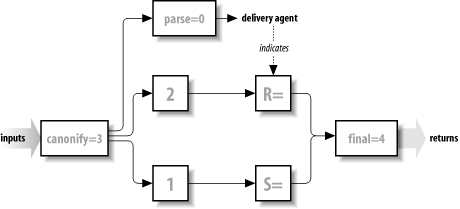Name
S=
Synopsis
The
S= delivery agent equate specifies a rule set to
be used for processing both envelope- and header-sender addresses.
The sender’s address is given in the envelope and
generally repeated in the mail message’s
From: header line.[19] The envelope
sender address is given to sendmail in one of
four ways: as a -f command-line argument; as an
SMTP MAIL FROM: command; as a From: header; or it
can be derived from the identity of the user who ran the program.
(Note that the latter two are used only during initial message
submission.) Figure 20-2 shows how the
S= rule set fits into the flow of addresses
through rule sets.
 |
There are two forms for the S= delivery agent
equate. One is the standard form, and the other is an enhanced
alternative beginning with V8 sendmail:
S=ruleset ← legal for all S=eset/hset ← legal beginning with V8
The first case specifies a rule set
(ruleset) that will process both recipient
and header addresses. If ruleset is zero
or if the entire S= delivery agent equate is
missing, no rule set is called.
In the second case, one rule set is specific to the envelope, and the
other is specific to headers. The envelope-specific rule is the one
to the left of the slash; the header-specific rule is the one to the
right (S=eset/hset). If
both values are missing, no sender S= processing is done. If only one is ...
Get Sendmail, 3rd Edition now with the O’Reilly learning platform.
O’Reilly members experience books, live events, courses curated by job role, and more from O’Reilly and nearly 200 top publishers.

